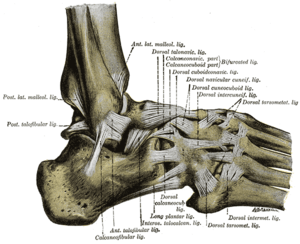Ottawa ankle rules
In medicine, the Ottawa ankle rules are a set of guidelines for clinicians to help decide if a patient with foot or ankle pain should be offered X-rays to diagnose a possible bone fracture. Before the introduction of the rules most patients with ankle injuries would have been imaged. However the vast majority of patients with unclear ankle injuries do not have bone fractures.[1] As a result, many unnecessary X-rays were taken, which was costly, time consuming and a slight health risk due to radiation exposure.

The Ottawa ankle rules
Ankle X-ray
Ankle X-ray is only required if:
- There is any pain in the malleolar zone; and,
- Any one of the following:
- Bone tenderness along the distal 6 cm of the posterior edge of the tibia or tip of the medial malleolus, OR
- Bone tenderness along the distal 6 cm of the posterior edge of the fibula or tip of the lateral malleolus, OR
- An inability to bear weight both immediately and in the emergency department for four steps.
Foot X-ray series
Additionally, the Ottawa ankle rules indicate whether a foot X-ray series is required. It states that it is indicated if:
- There is any pain in the midfoot zone; and,
- Any one of the following:
- Bone tenderness at the base of the fifth metatarsal (for foot injuries), OR
- Bone tenderness at the navicular bone (for foot injuries), OR
- An inability to bear weight both immediately and in the emergency department for four steps.
Certain groups are excluded, in particular pregnant women, and those with diminished ability to follow the test (for example due to head injury or intoxication). Several studies strongly support the use of the Ottawa Ankle Rules in children over 6 (98.5% sensitivity);[2] however, their usefulness in younger children has not yet been thoroughly examined.
Usefulness
The rules have been found to have a very high sensitivity, moderate specificity, and therefore a very low rate of false negatives. Evidence supports the rules as an accurate instrument for excluding fractures of the ankle and mid-foot, reducing the number of unnecessary investigations and length of stay in emergency departments.[3]
The original study reported that the test was 100% sensitive and reduced the number of ankle X-rays by 36%.[4] A second trial with a larger number of patients replicated these findings.[5] Subsequently, a multi-centre study explored the feasibility of implementing the rules on a wider scale.[6] Unfortunately, teaching the rules to patients does not appear to help reduce presentation to hospital.[7]
History
This list of rules was published in 1992 by a team of doctors in the emergency department of the Ottawa Civic Hospital in Ottawa, Canada.[4] Since the rules were formulated in Ottawa they were dubbed the Ottawa ankle rules by their creators a few years after their development, a title that has stuck.[5] In this respect, the naming of the rules is similar to that of the Bristol stool scale or the Glasgow Coma Scale (GCS), which also take their names from the cities in which they were formulated.
Related rules
The original rules were developed for ankle and foot injuries only, but similar guidelines have been developed for other injuries such as the Ottawa knee rules.[8][9]
References
- Sujitkumar P, Hadfield JM, Yates DW (June 1986). "Sprain or fracture? An analysis of 2000 ankle injuries". Arch Emerg Med. 3 (2): 101–6. doi:10.1136/emj.3.2.101. PMC 1285323. PMID 3089238.
- Dowling S, Spooner CH, Liang Y, et al. (April 2009). "Accuracy of Ottawa Ankle Rules to exclude fractures of the ankle and midfoot in children: a meta-analysis". Acad Emerg Med. 16 (4): 277–87. doi:10.1111/j.1553-2712.2008.00333.x. PMID 19187397.
- Curr S, Xyrichis A (2015). "Does nurse-led initiation of Ottawa ankle rules reduce ED length of stay?". International Emergency Nursing J. 23 (4): 317–322. doi:10.1016/j.ienj.2015.01.006. PMID 25779054.
- Stiell IG, Greenberg GH, McKnight RD, Nair RC, McDowell I, Worthington JR (April 1992). "A study to develop clinical decision rules for the use of radiography in acute ankle injuries". Ann Emerg Med. 21 (4): 384–90. doi:10.1016/s0196-0644(05)82656-3. PMID 1554175.
- Stiell IG, McKnight RD, Greenberg GH, et al. (March 1994). "Implementation of the Ottawa ankle rules". JAMA. 271 (11): 827–32. doi:10.1001/jama.1994.03510350037034. PMID 8114236.
- Stiell I, Wells G, Laupacis A, et al. (September 1995). "Multicentre trial to introduce the Ottawa ankle rules for use of radiography in acute ankle injuries. Multicentre Ankle Rule Study Group". BMJ. 311 (7005): 594–7. doi:10.1136/bmj.311.7005.594. PMC 2550661. PMID 7663253.
- Blackham JE, Claridge T, Benger JR (2008). "Can patients apply the Ottawa ankle rules to themselves?" (PDF). Emergency Medicine Journal. 25 (11): 750–751. doi:10.1136/emj.2008.057877. PMID 18955612.
- Stiell IG, Greenberg GH, Wells GA, et al. (February 1996). "Prospective validation of a decision rule for the use of radiography in acute knee injuries". JAMA. 275 (8): 611–5. doi:10.1001/jama.275.8.611. PMID 8594242.
- Stiell I. "Ottawa Knee Rule". Clinical Decision Rules. Emergency Medicine Research Group, Ottawa Hospital Research Institute.
External links
- "Ottawa Ankle Rules: Poster" (PDF). Clinical Decision Rules. Emergency Medicine Research Group, Ottawa Hospital Research Institute.
- "Ottawa knee rule OK". Bandolier. 49. March 1998. — an independent journal about evidence-based medicine.
- "Ottawa rules for x-ray of knee, ankle and foot". gp-training.net — a GP education and training resource. Archived from the original on 2008-03-20. (graphical explanation).